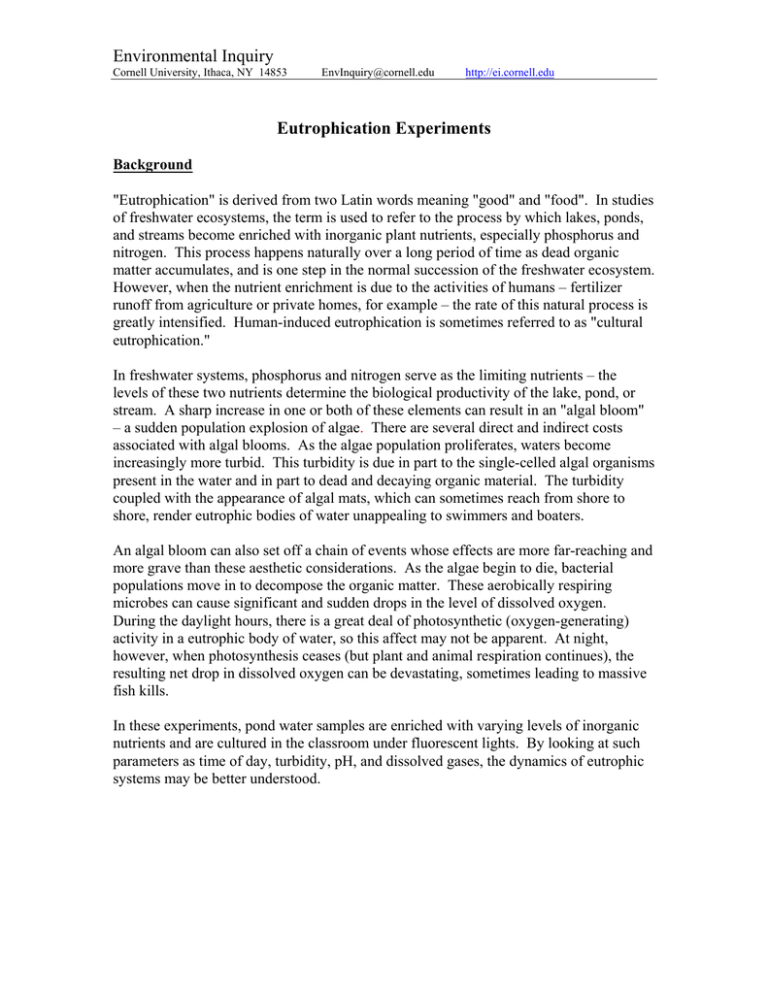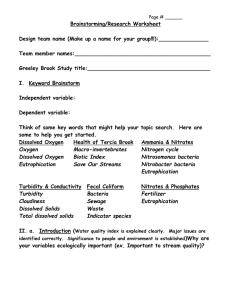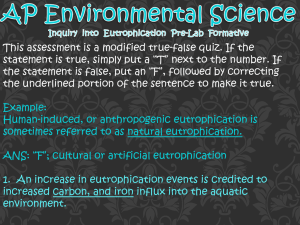Eutrophication Experiments - Environmental Inquiry
advertisement

Environmental Inquiry Cornell University, Ithaca, NY 14853 EnvInquiry@cornell.edu http://ei.cornell.edu Eutrophication Experiments Background "Eutrophication" is derived from two Latin words meaning "good" and "food". In studies of freshwater ecosystems, the term is used to refer to the process by which lakes, ponds, and streams become enriched with inorganic plant nutrients, especially phosphorus and nitrogen. This process happens naturally over a long period of time as dead organic matter accumulates, and is one step in the normal succession of the freshwater ecosystem. However, when the nutrient enrichment is due to the activities of humans – fertilizer runoff from agriculture or private homes, for example – the rate of this natural process is greatly intensified. Human-induced eutrophication is sometimes referred to as "cultural eutrophication." In freshwater systems, phosphorus and nitrogen serve as the limiting nutrients – the levels of these two nutrients determine the biological productivity of the lake, pond, or stream. A sharp increase in one or both of these elements can result in an "algal bloom" – a sudden population explosion of algae. There are several direct and indirect costs associated with algal blooms. As the algae population proliferates, waters become increasingly more turbid. This turbidity is due in part to the single-celled algal organisms present in the water and in part to dead and decaying organic material. The turbidity coupled with the appearance of algal mats, which can sometimes reach from shore to shore, render eutrophic bodies of water unappealing to swimmers and boaters. An algal bloom can also set off a chain of events whose effects are more far-reaching and more grave than these aesthetic considerations. As the algae begin to die, bacterial populations move in to decompose the organic matter. These aerobically respiring microbes can cause significant and sudden drops in the level of dissolved oxygen. During the daylight hours, there is a great deal of photosynthetic (oxygen-generating) activity in a eutrophic body of water, so this affect may not be apparent. At night, however, when photosynthesis ceases (but plant and animal respiration continues), the resulting net drop in dissolved oxygen can be devastating, sometimes leading to massive fish kills. In these experiments, pond water samples are enriched with varying levels of inorganic nutrients and are cultured in the classroom under fluorescent lights. By looking at such parameters as time of day, turbidity, pH, and dissolved gases, the dynamics of eutrophic systems may be better understood. Eutrophication Experiments Environmental Inquiry http://ei.cornell.edu 2 Experiment #1 (Standard Problem) Design an experiment to assess the changes in the dynamics of a freshwater system (interplay of such parameters as turbidity, pH, CO2) as nutrients become increasingly more available. Suggested Steps Engagement Before class, obtain water samples from two different ponds, lakes, or streams in your area – one that is considerably eutrophic and one that is not. Try to get a representative sample of both the life and the inorganic material present in the body of water (algae, aquatic insects, bottom substrate, etc.) Place the samples in clear containers – tanks, if you have them, or gallon milk jugs. Ask your students to observe the two different water samples and to write down their observations. Encourage them to pay attention to detail; for instance, be sure they note both color and turbidity. Can you see any bubbles? What do the plants and/or animals you see look like? Does the water have an odor? Point out that their observations may include sketches. Ask students to write a brief paragraph in which they predict the relative amounts of nutrients – nitrates and phosphates – in the water samples (there are more nutrients in "A" than in "B"). What observations are their predictions based on? Time permitting, it would also be interesting for students to compare the two water samples under a microscope. Exploration Run Experiment #1. Have students bring in clear, 1-liter plastic soda bottles from home to serve as aquaria and set up the aquaria in plastic milk crates arranged under low wattage fluorescent lights. You'll want to set up three different sets of aquaria/fluorescent light/timer apparatuses on staggered 10 hour photo periods. The goal here is to simulate morning, midday, and nighttime readings while the students are in class. Ideally, each student will have one aquaria (one bottle) in each of the three set ups. If there is not enough room for this, however, students can work in small groups. The aquaria should be placed away from a window or any other Eutrophication Experiments Environmental Inquiry http://ei.cornell.edu 3 source of bright light, if the simulated photo periods are to be valid. Stock the students' aquaria with mildly eutrophic (slightly turbid) pond water. You'll want to get the water for all students' aquaria from the same body of water at the same time. After taking the initial set of measurements, fertilize each student's aquarium to a different extent. Starting with a control to which no fertilizer was added, we added fertilizer in increments of 5ml's and covered a range of 5ml to 35ml. Be certain that you have a replicate at each concentration -in each of the three photo periods. To provide every student with a complete set of data, have students enter their data into a master data sheet, which you can then run off and distribute to everyone. Explanation and Elaboration This is where your students analyze and interpret their data. We encourage you to try something different than the usual lab write-up, but obviously that's up to you. The format we suggest : I. Prediction Statement – should be written before the experiment is carried out II. Lab Log – What you did and when; problems that arose and how you addressed them III. Interpretation – A summary and explanation of your data, preferably using graphs and/or tables IV. Tips for Future Experimenters – Recommendations for improving upon or extending the research, addressed to students taking the class next year Evaluation Some form of assessment. We provide some suggestions later in this packet. Eutrophication Experiments Environmental Inquiry http://ei.cornell.edu 4 Experimental Problem #2 (Original Problem) These experiments should be original. Some possible ideas: Design an experiment that could be used to compare the effects of nutrient enrichment on two different bodies of water Design an experiment to determine what types of household items might be contributing to cultural eutrophication (i.e.: many detergents contain phosphorus, lawn fertilizer contains nitrogen). Design an experiment to determine whether or not there is a marked difference in the biological consequences of continuous low-level nutrient enhancement and sudden high-level nutrient enhancement. Materials • • • • • • • • • • Pond water Test kits for dissolved phosphate, nitrate, and CO2 1-liter soda bottles Six milk crates Three digital timers Three fluorescent light fixtures Three 20 Watt fluorescent bulbs Liquid houseplant fertilizer Dissolved oxygen meter Spectrophotometer (turbidity) Eutrophication Experiments Environmental Inquiry http://ei.cornell.edu 5 Assessment Items Traditional Items 1. A pond in the field behind your school is covered virtually from shore to shore with a mat of algae. There are several patches of water lilies on the surface, as well, and duckweed lines the pond's edges. At 2:00pm on a sunny summer afternoon, you would expect the pH to be (a) 5.5 (b) 7.0 (c) 8.5 (d) It is impossible to say from the information given (you may assume the pond has not been affected by acid precipitation). 2. Although you measured the dissolved oxygen content of the pond when you measured the pH, you can't fall asleep later that night because you can't get your mind off that pond! You decide to go back out to the pond at 11:30pm and test your hypothesis that (a) The dissolved oxygen concentration will be higher than it was in the afternoon. (b) The dissolved oxygen concentration will be lower than it was in the afternoon. (c) The dissolved oxygen concentration will be about the same as it was in the afternoon. (d) It is impossible to make a reasonable prediction. 3. There is a second pond behind your school differing from the first one only in that it has been stocked with perch and catfish. The dissolved oxygen concentration in the fish pond will be (a) Greater than the dissolved oxygen concentration in the non-fish pond during the day but less than the non-fish pond at night. (b) Greater than the dissolved oxygen concentration in the non-fish pond at night but greater than the non-fish pond during the day. (c) Always lower than the dissolved oxygen concentration in the non-fish pond. (d) Always higher than the dissolved oxygen concentration in the non-fish pond. Authentic Assessment Item Part I. Design an experiment to test the prediction that phosphorus enrichment has a more acute affect on nighttime dissolved oxygen content than does nitrogen enrichment. Eutrophication Experiments Environmental Inquiry http://ei.cornell.edu 6 Write a paragraph clearly describing your experiment and use schematic drawings, flowcharts, graphs, and/or tables to enhance your design, as you see fit. Part II. Trade your experimental design with another student. Write a short paragraph analyzing the strengths and weaknesses of your classmate's design. Think about ways in which your classmate's design is better than your own and also ways in which yours is better. Whether you constructively criticize or compliment a certain aspect of the design, be specific -- provide details. Finally, suggest a plan for strengthening any weak aspects of the design. Credits This exercise was written by staff of the Institute on Science and the Environment for Teachers at Cornell University under NSF Award #9454428.


